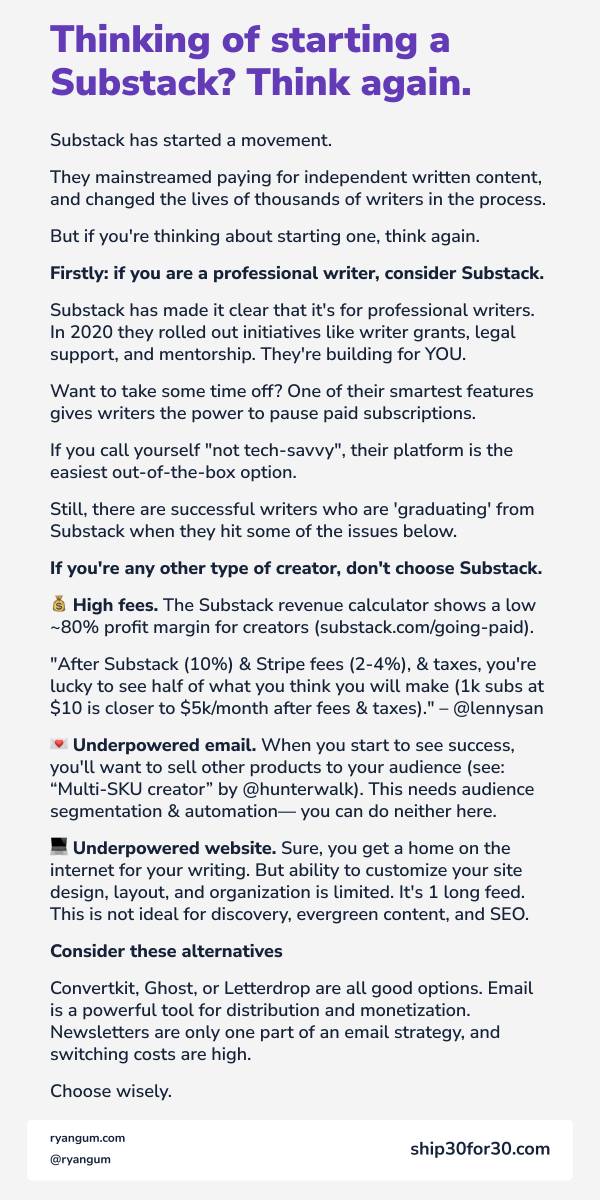
As someone working in the creator economy space, I love the movement that Substack started.
They mainstreamed paying for independent writing, and changed the lives of thousands of writers in the process.
But they're building for a specific type of creator.
They mainstreamed paying for independent writing, and changed the lives of thousands of writers in the process.
But they're building for a specific type of creator.
Substack has made it clear that they're focusing on professional writers.
(Putting my product hat on, this is a smart strategy for them to differentiate and win a specific market)
In 2020 they rolled out initiatives like grants, legal support, and mentorship for writers.
(Putting my product hat on, this is a smart strategy for them to differentiate and win a specific market)
In 2020 they rolled out initiatives like grants, legal support, and mentorship for writers.
If you call yourself "not tech-savvy", their platform is the easiest out-of-the-box option.
Want to take some time off? One of their smartest features gives writers the power to pause paid subscriptions.
Want to take some time off? One of their smartest features gives writers the power to pause paid subscriptions.
If you're a professional writer, Substack might be a good option for you to start with.
But, there are successful writers who are 'graduating' from Substack when they discover a few problems.
But, there are successful writers who are 'graduating' from Substack when they discover a few problems.
https://twitter.com/austin_rief/status/1339028168527781890
If you're any other type of creator, don't choose Substack. 3 main reasons why:
💰 High take rate
The Substack revenue calculator (substack.com/going-paid) shows ~80% profit margin for creators. Competitors are closer to 95%.
💰 High take rate
The Substack revenue calculator (substack.com/going-paid) shows ~80% profit margin for creators. Competitors are closer to 95%.
https://twitter.com/lennysan/status/1265072097849602048
💌 Underpowered email
When you start to see success, you'll want to sell other products to your audience (see: “Multi-SKU creator” by @hunterwalk). This needs audience segmentation & automation—you can do neither here.
When you start to see success, you'll want to sell other products to your audience (see: “Multi-SKU creator” by @hunterwalk). This needs audience segmentation & automation—you can do neither here.
https://twitter.com/hunterwalk/status/1343589375884492800
💻 Underpowered website
Sure, you get a home on the internet for your writing. But ability to customize your site design, layout, and organization is limited. It's 1 long feed. This is not ideal for discovery, evergreen content, and SEO.
Sure, you get a home on the internet for your writing. But ability to customize your site design, layout, and organization is limited. It's 1 long feed. This is not ideal for discovery, evergreen content, and SEO.
Consider these alternatives
@ConvertKit , @Ghost, or @letterdropco are all good options.
Email is a powerful tool for distribution and monetization. Newsletters are only one part of an email strategy, and switching costs are high.
Choose wisely.
@ConvertKit , @Ghost, or @letterdropco are all good options.
Email is a powerful tool for distribution and monetization. Newsletters are only one part of an email strategy, and switching costs are high.
Choose wisely.
Related reading:
https://twitter.com/nathanbarry/status/1326322219627155456
If you enjoyed this thread and want to learn more about the Creator Economy space, follow me @ryangum and subscribe to my upcoming posts:
ryangum.com
ryangum.com
• • •
Missing some Tweet in this thread? You can try to
force a refresh




